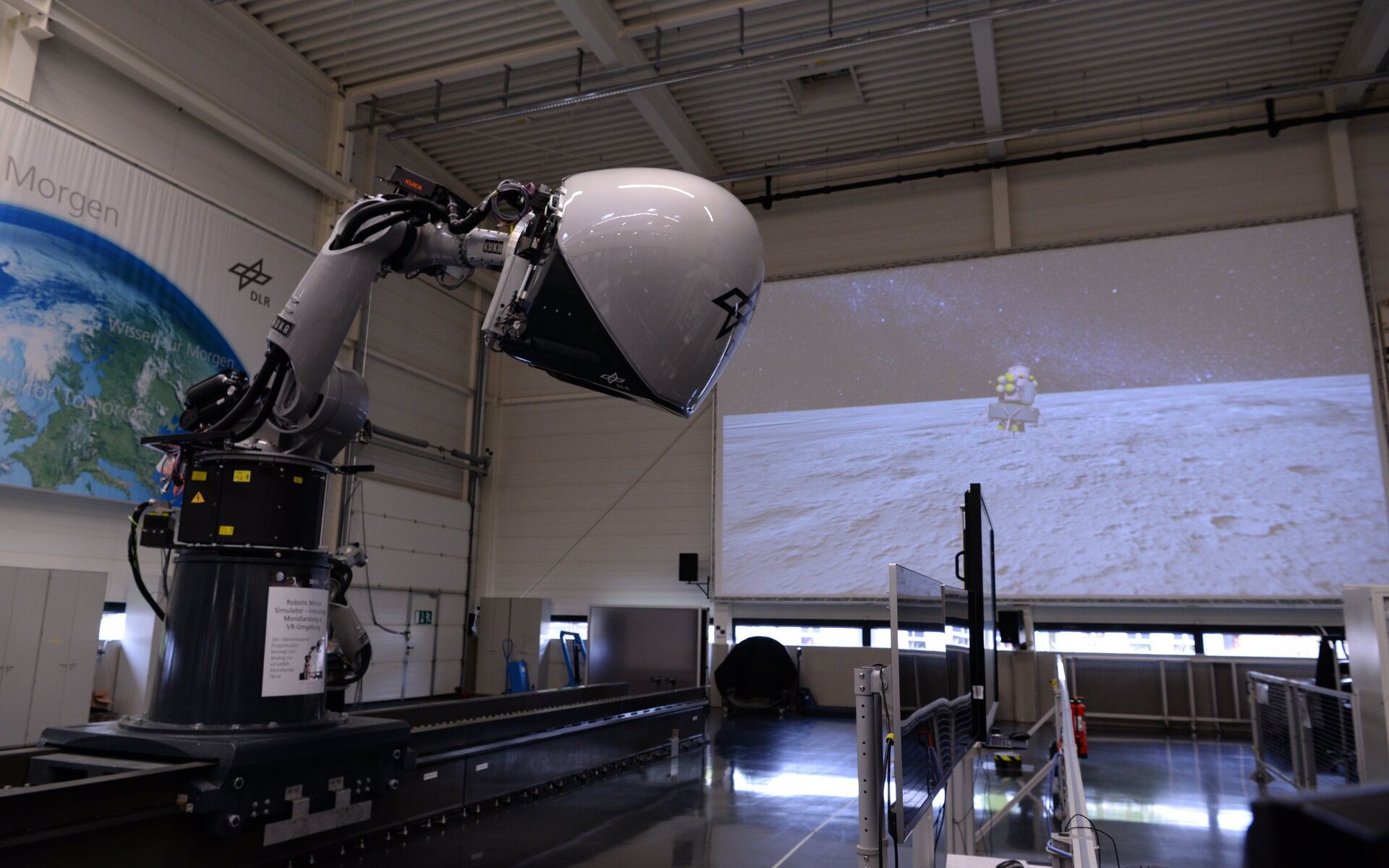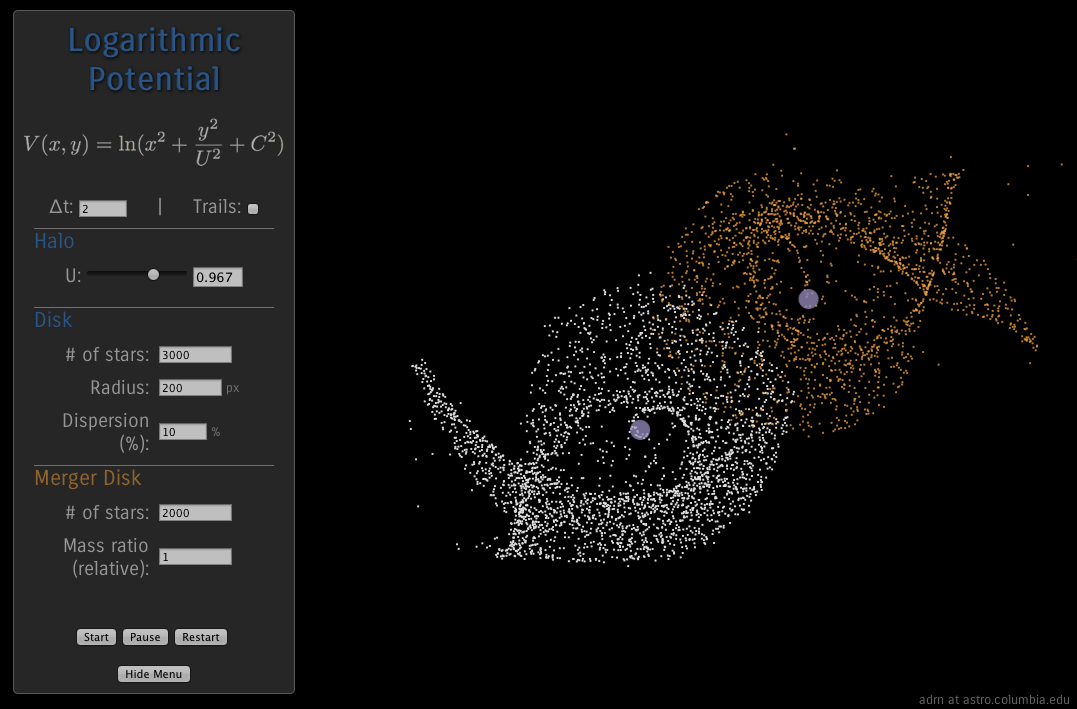The European Space Agency (ESA) is learning how to touch down safely at the South Pole of the Moon, without ever leaving Earth. Actual Moon landings seem to be on the horizon in the next decade via the Artemis program, and astronauts are going to have to learn to handle the unique challenges of landing in the Moon’s polar environment. With low angle sunlight and deep, permanently shadowed craters, the Moon’s South Pole poses difficulties no Apollo mission ever faced. To get hands-on experience with this environment without risking human life, ESA is putting astronauts through their paces on high-tech simulators.
Continue reading “Astronauts are Practicing Landing at the Moon's South Pole”Fly to Rosetta’s Comet with this New Interactive Visualization
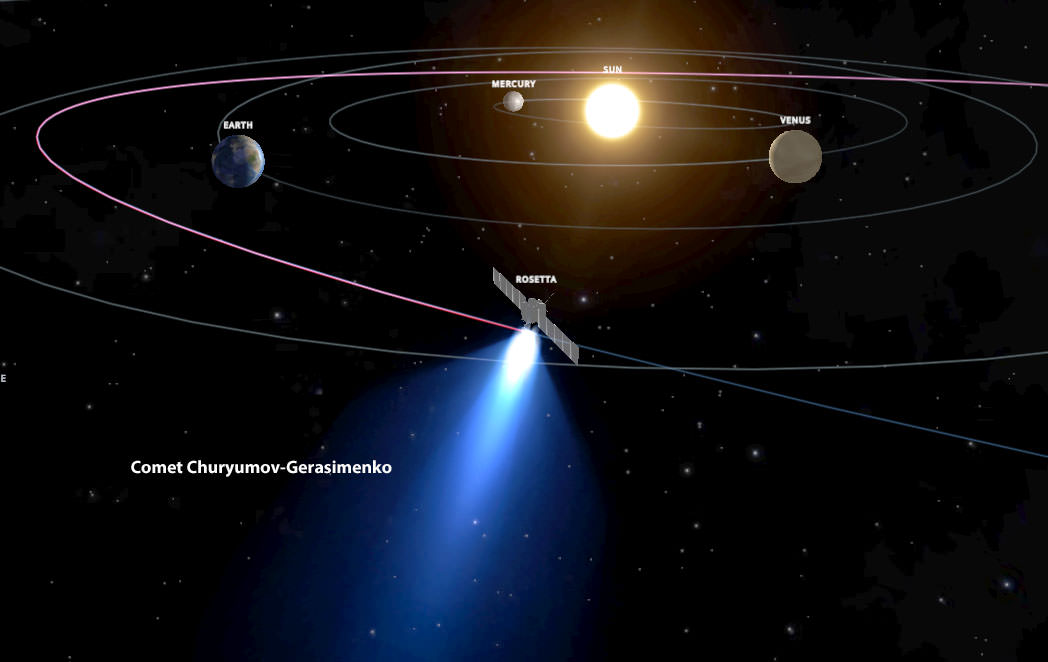
Hang onto your space helmets. With a few moves of the mouse, you can now follow the European Rosetta mission to its target comet with this interactive 3-D simulator. Go ahead and give it a click – it’s live! The new simulator was created by INOVE Space Models, the same group that gave us the 3-D solar system and Comet ISON interactive models.
The embedded version gives you a taste, so be sure to also check out the full-screen version. You can either click play to watch the mission from start to finish or you can drop it at key points by selecting from list of 11 highlights on the left side of your screen. A tick-tock at the bottom of the screen helps reference the time and what the spacecraft is doing at that moment in the video.
To interact with the model, simply click the screen. The action stops, allowing you to zoom in and out by scrolling; to change orbital viewpoints hold down the mouse button and drag. So easy!
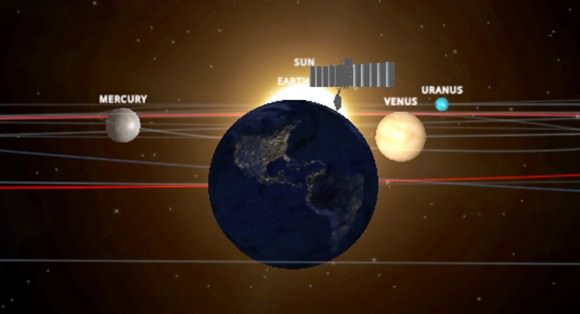
I like the realism of the simulation, the attention paid to the planets’ variable spin rates and orbital periods and how well model illustrates the complicated maneuvers required to “fling” the probe to Comet Churyumov-Gerasimenko. And I do mean fling. Watching the video from a face-on solar system perspective I was struck by how Rosetta’s flight path resembled a spiral after repeated gravity assists by Mars and Earth.
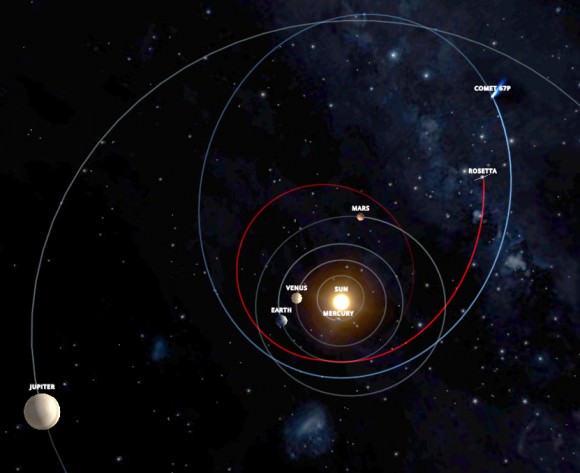
Whether you’re a teacher or an armchair space enthusiast looking for an easy-to-understand, graphic way to find out how Rosetta will meet its target, I doubt you’ll find a more effective tool.
See Comet ISON Fly through Earth’s Sky with this Awesome Interactive Simulator
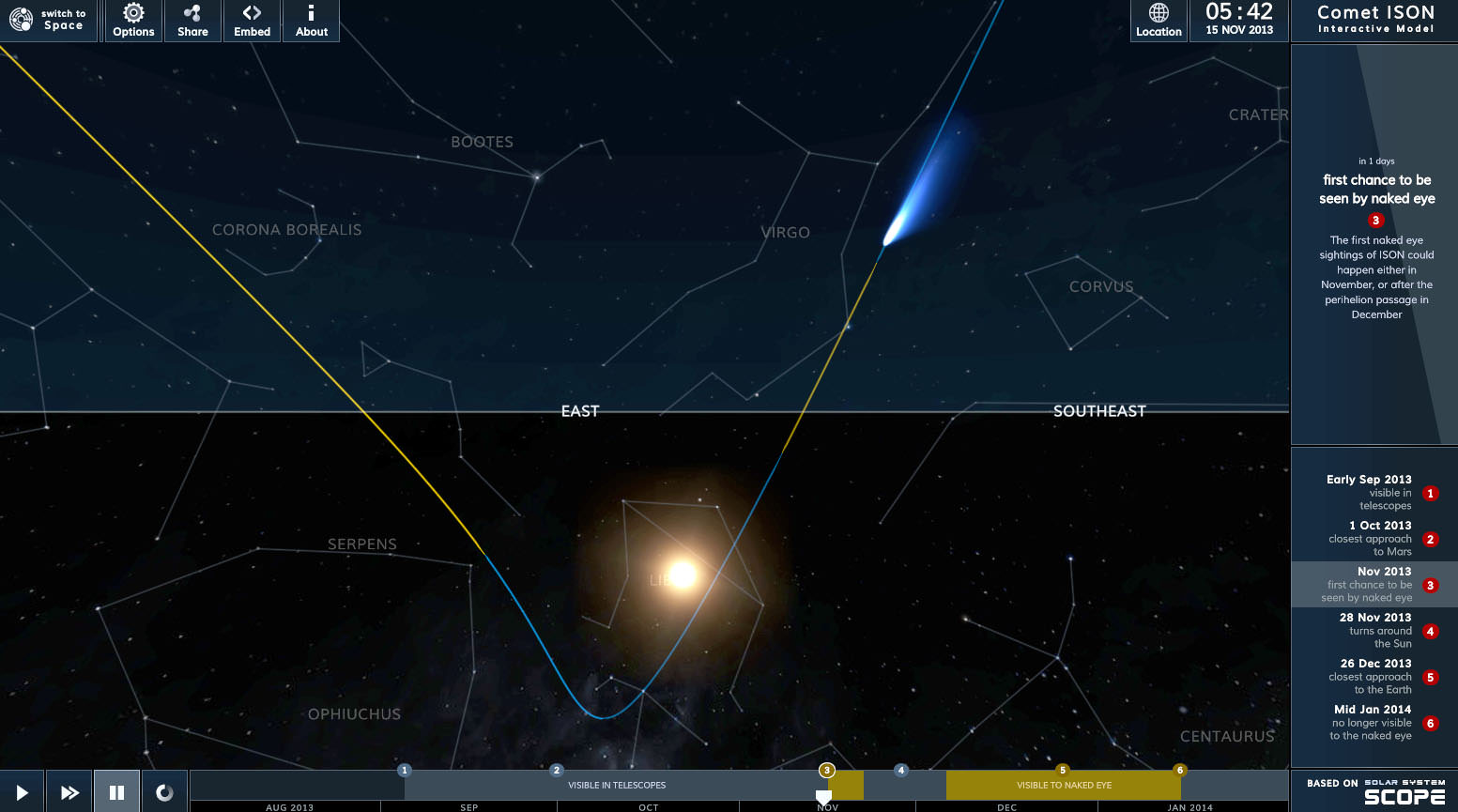
Here’s a handy tool. The folks at INOVE Space Models have just updated their awesome Comet ISON flyby simulation with a second point of view – how it looks from Earth. The first version let us watch from afar as ISON dives across across the solar system until it makes a hard left at the sun and returns to deep space. The new view lets you watch it track across the sky across from any location on Earth. Go to the link and toggle the Switch to Earth option in the upper left of the display and you’re off. The website attempts to automatically pinpoint where you are, but for me it was a tad off, selecting a town about 75 miles away. But a few miles this way or that make little difference given how far the comet is from Earth. If you need to make an adjustment, click the Location icon (upper right) and select your latitude and longitude.
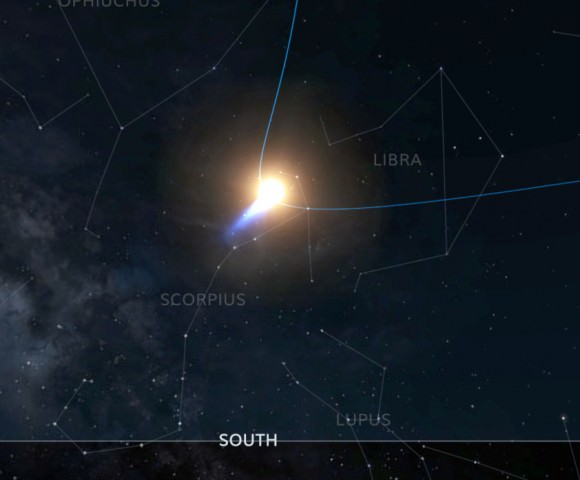
You have two options for viewing. If you click the single arrow play button at the bottom of the screen, the display shows a horizon line with the stars, sun and comet rising and setting over a single day. In a day’s time the comet moves only a small distance in the sky, so it will appear in nearly the same spot the next day. Except around perihelion on Nov. 28. Then it moves so quickly – over 800,000 mph (1.3 million km) – fast enough to watch move hour by hour.
Besides just being plain cool to watch, the simulator is truly useful. The background star field shows constellation outlines and stars down to about 5th magnitude. Assuming the comet is reasonably bright, say 5th magnitude or brighter, you can use the simulations as locator maps now through the end of January. By clicking on the Time Box at upper right, you can set it to any time you like, grab a frame and head outside for a look.
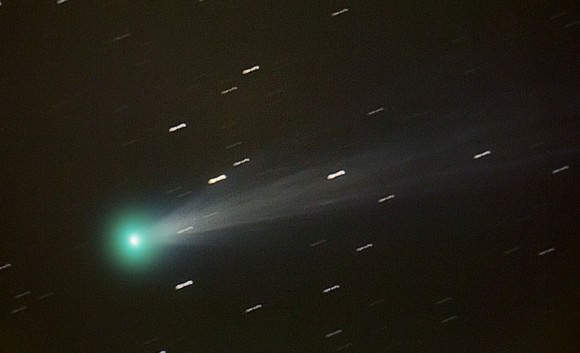
Pressing the double arrow fast-forward button shows changes in position one day after another. To know what day you’re on just consult the timeline at the bottom of your screen. You can manually pull the time arrow to speed up, slow down or select a particular time of month. Other refinements are available in the Options box at upper left. Should you tire with Comet ISON from an earthly perspective, just click on Switch to Space at upper left and you’ll zoom back out for a solar system perspective. Enjoy the journey!
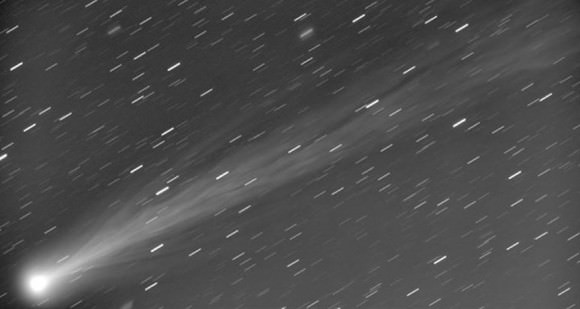
The un-simulated Comet ISON underwent a powerful outburst on Nov. 14 brightening by two magnitudes, as the two images here from Leonid Elenin and Scott MacNeil attest (and you can see more in our article from yesterday)
What had been a faint object in binoculars has become much more impressive. I caught it in my 10x50s in some small cracks between the clouds this morning (Nov. 15) and estimated its magnitude at 5.0. Had it been clear, I would have seen it with the naked eye. Through a 15-inch (37 cm) telescope at 64x the coma, now twice its pre-outburst diameter, glowed more blue than green with a dense core that looked like a bright, fuzzy star. Frankly, ISON was beautiful. Let’s hope this little outburst leads to better things to come and not early signs of the comet’s dissolution. Take a look yourself at the next opportunity and there might be a surprise waiting for you.
A Virtual Galactic Smash-Up!
An online simulator for galactic collisions (Adrian Price-Whelan/Columbia University)
Have you ever had the desire to build your own galaxies, setting your own physical parameters and including as many stars as you want, and then smash them together like two toy cars on a track? Well, now you can do just that from the comfort of your own web browser (and no waiting billions of years for the results!)
This interactive online app by Adrian Price-Whelan lets you design a galaxy, including such parameters as star count, radius and dispersion rate, and then create a second galaxy to fling at it. Clicking and dragging on the black area will send the invading galaxy on its course, letting you watch the various results over and over again. (If those SMBH’s hit, look out!)
 In reality many galaxies have gone through (or are going through, from our perspective) such collision events, our own Milky Way being no exception. In fact, the Milky Way is on course to collide with the Andromeda Galaxy… in about 4 billion years.
In reality many galaxies have gone through (or are going through, from our perspective) such collision events, our own Milky Way being no exception. In fact, the Milky Way is on course to collide with the Andromeda Galaxy… in about 4 billion years.
So while we wait patiently for that, this is just a bit of addictive fun to distract you from your Cyber Monday shopping spree. Enjoy!
(Source: Columbia University Astronomy & Physics)
Inset image: Hubble interacting galaxies UGC 9618, 450 million light-years away. Credit: NASA, ESA, the Hubble Heritage (STScI/AURA)-ESA/Hubble Collaboration, and A. Evans (University of Virginia, Charlottesville/NRAO/Stony Brook University)

